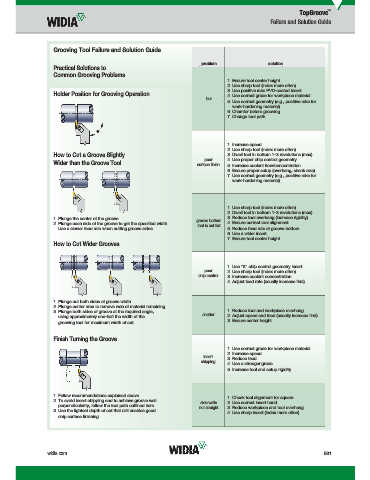Page 563 - Master Catalog 2017, Inch
P. 563
TopGroove
™
Failure and Solution Guide
Grooving Tool Failure and Solution Guide
problem solution
Practical Solutions to
Common Grooving Problems
1. Ensure tool center height.
2. Use sharp tool (index more often).
3. Use positive rake PVD-coated insert.
Holder Position for Grooving Operation 4. Use correct grade for workpiece material.
bur
5. Use correct geometry (e.g., positive rake for
work-hardening material).
6. Chamfer before grooving.
7. Change tool path.
1. Increase speed.
2. Use sharp tool (index more often).
How to Cut a Groove Slightly 3. Dwell tool in bottom 1–3 revolutions (max).
poor 4. Use proper chip control geometry.
Wider than the Groove Tool surface fi nish 5. Increase coolant fl ow/concentration.
6. Ensure proper setup (overhang, shank size).
7. Use correct geometry (e.g., positive rake for
work-hardening material).
1. Use sharp tool (index more often).
2. Dwell tool in bottom 1–3 revolutions (max).
1. Plunge the center of the groove. 3. Reduce tool overhang (increase rigidity).
groove bottom
2. Plunge each side of the groove to get the specifi ed width. 4. Ensure correct tool alignment.
that is not fl at
Use a slower feed rate when cutting groove sides. 5. Reduce feed rate at groove bottom.
6. Use a wider insert.
7. Ensure tool center height.
How to Cut Wider Grooves
1. Use “K” chip control geometry insert.
poor 2. Use sharp tool (index more often).
chip control 3. Increase coolant concentration.
4. Adjust feed rate (usually increase fi rst).
1. Plunge out both sides of groove width.
2. Plunge center area to remove web of material remaining.
1. Reduce tool and workpiece overhang.
3. Plunge both sides of groove at the required angle,
chatter 2. Adjust speed and feed (usually increase fi rst).
using approximately one-half the width of the
3. Ensure center height.
grooving tool for maximum width of cut.
Finish Turning the Groove
1. Use correct grade for workpiece material.
2. Increase speed.
insert
chipping 3. Reduce feed.
4. Use a stronger grade.
5. Increase tool and setup rigidity.
1. Follow recommendations explained above. 1. Check tool alignment for square.
2. To avoid insert chipping and to achieve groove wall side walls 2. Use correct insert hand.
perpendicularity, follow the tool path outlined here. not straight 3. Reduce workpiece and tool overhang.
3. Use the lightest depth of cut that still enables good 4. Use sharp insert (index more often).
chip surface fi nishing.
widia.com E91
b 92015316PM
WID_Master16_Turning_Grooving&CutOff_E090_E091_Minch_REBRAND.indd 91 L V i WID M 16 T i G i &C Off E090 E091 Mi h REBRANDN 11/10/15 11:14 AM

